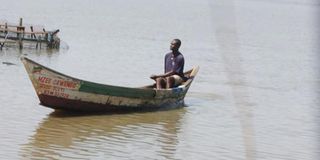
Fishermen prepare for a fishing expedition in Lake Victoria at Usoma Beach in 2019.
| Jeff Angote | Nation Media GroupCounties
Premium
Desperate voices from the lake: Dear fish, where art thou?
As thousands return to the warmth of their families at dusk, fishermen in Lake Victoria assemble their gear for the long night ahead.
Like Andrew and Peter in the scriptures, they brave the elements to support their families from one of the oldest professions. There are days when they are blessed with a great catch, but on other days they return ashore empty handed.
Due to the dwindling stocks, they have had to come up with strategies to sustain a steady supply of Mbuta (Nile Perch), Ngege (Tilapia), Kamongo (Lung fish), Dagaa or Omena (Silver Cyprinid) and Mumi (Mudfish).
Every successful expedition in the lake is considered a miracle.

Fishermen prepare for a fishing expedition in Lake Victoria at Usoma Beach in 2019.
They sometimes find themselves in the crosshairs of foreign forces, particularly Ugandan and Tanzanian security agents when they accidentally cross the boundaries.
We recently visited fishermen at Litare Beach in Rusinga Island, Mbita Sub-county, for a better perspective. In the evening, they inspect their motorised boats for any leaks, then fill the engines with petrol.
Each has a reflector jacket for safety and a raincoat. In the vessels, there are fishing nets and solar-powered lights that are essential in catching silver cyprinid or sardines (omena or dagaa).
After they set out at 7pm, they switch on the lights, which act as a bait and patiently wait for fish to swim towards the nets. At night, the small fish are naturally drawn to sources of light, so it’s always easier for them.

A fisherman on Lake Victoria.
Unlucky fishermen usually catch ochonga – smaller than omena – which is used as chicken feed. Mr George Omondi has noticed a difference between past and present fishing practices. When he started out in 1994, they were using kerosene lanterns in fishing expeditions.
In the past, omena fishing was also regulated.
In the scramble for fish in the early 2000s, Omondi started noticing the difference in the quantity of omena he got from the lake. This is because fishermen had started replacing the lanterns with bright LED lights, which is believed to be one of the major causes of dwindling stocks.
“The lanterns used to have limited light and controlled the catch. The LED lights are very powerful and attract a lot of fish, which are taken out at once,” says Mr Omondi.
Dozens of boats with these bright lights spread out hundreds of kilometres every night. One boat can have up to five LED lights, which are mounted on wooden frames. The technique attracts fish located deep in the lake.
“There’s no space for fish to breed and multiply. The ones that were beneath the water are also fished out. This reduces the amount of fish we get each day because of reduced breeding,” says Mr Omondi.
Different companies have taken advantage of this to supply fishermen with LED lights at affordable prices.
Some rules set to regulate the fishing of omena have largely been ignored. In the past, fishing was prohibited when the moon was bright. This was meant to encourage fish to breed. Today, nobody gives fish any chance to breed and nobody cares how they get the fish. The end justifies the means.
The reckless abandon with which the fishing communities are going about their activities is beginning to take a toll on their fortunes. When the nets are pulled out of water, just a small quantity of omena is scooped out.
The reality of what’s happening in the lake usually becomes evident at 5am when the first boat approaches the beach. They have returned empty handed after spending up to nine hours out in the lake.
For the lucky few, a scramble for the available omena by traders begins. After about an hour of haggling and compromises, the noise subsides. The boats are docked along the shores, waiting for dusk again.
At Litare Beach, traders use water troughs to measure the quantity of omena for sell. Each trough of omena costs Sh1,000.
About two decades ago, it was easy to fill up to 10 troughs and a kilo was sold at Sh400. Now, a team of about six fishermen has to share the profits and losses of two troughs of fish with the boat owner. It’s hell.
“At the end of the working shift, a fisherman will walk home with less than Sh500, which cannot sustain most families,” offers Omondi.
Litare Beach has 200 registered fishing boats and there are other applications awaiting approval. The more the boats, the tougher the job. But the challenges do not only affect fishermen going out for omena.
At Sare Beach in Suba Sub-county, where the Nile perch (mbuta) is common, fishermen also complain about dwindling stocks.
Sub-County Beach Management Unit (BMU) chairman William Onditi says the catch has been decreasing daily and it’s causing worries. The Nile perch was introduced to the lake in the 1950s.
Its population grew exponentially and became a threat to other species of fish, which are still their prey. Today, the Nile perch is under threat of extinction due to uncontrolled activities by local fishermen.
Those out for quick cash have been taking out juvenile fish. At the local markets, juvenile fish are sold in plenty. Mature Nile perch can measure up to seven kilogrammes, but some fishermen take them out of water when they weigh a fraction of a kilo.
“When it’s raining, it’s found at the section of the lake where rivers discharge their water. The runoff has plenty of feed for the fish. When water is discharged into the lake, fishermen turn their boats to areas that have plenty of supply,” he says.
Too much rain also has an effect on fish availability as it affects water temperature. Mr Onditi says fish tend to avoid cold water and would swim deep into the bottom of the lake during the rainy season.
At Sare Beach, Nile perch stocks have also reduced. The daily catch is less than a tonne, down from 10 tonnes in 2016. The good thing with Mbuta is that fishing can be done any time of the day.
Factories that used to run the local economy no longer hire people in production of processed fish. Only one fish factory, Lake Treasures Limited, is operating in Homa Bay County. It’s one of the two firms in Nyanza that are still in operation.
The others closed shop due to the dwindling stocks. Lake Treasures Limited General Manager Surendra Shetty says they used to process up to 15 tonnes of fish daily in 2009.
All machines at the plant based in Mbita town were running and they had hired more than 200 workers. Most of the processed fish was exported to the European Union. It now takes up to two weeks to process 15 tonnes of fish.
“We sometimes operate three times a week unlike before when we operated six times a week. We now source for fish from Homa Bay and Siaya, but what we get is below our processing capacity,” says Mr Shetty.
Homa Bay Fisheries director George Okoth says the county used to produce 100,000 metric tonnes of fish two decades ago, but it’s now down to 25,000 metric tonnes.
With many people to look after, government officials controlling fishing activities in Lake Victoria find it hard to keep an eye on each boat. Fishermen have taken advantage of this to engage in bad practices, which affect the lake ecosystem.
Homa Bay County Agriculture executive Aguko Juma laments that many fishermen employ poor practices to meet the high demand for fish. Trawling, which is illegal, is also common. This is where a large net is pulled along the lake floor to catch fish.
The Kenya Coast Guard and Kenya Maritime Authority (KMA) are fighting such practices but the notorious fishermen are always a step ahead.
“Some fishermen have taken advantage of the fact that the vast lake makes it difficult for authorities to get them. They should be warned that we will catch up with whoever engages in illegal practices,” warns Mr Juma.
The county administration has also played a part in the mess by neglecting the sector. Mr Juma says the devolved unit only used to focus on crop and livestock farmers. He wants to change this and support aquaculture.
To reduce the pressure on the resources in the lake, the Ministry of Agriculture and Fisheries now encourages fish ponds.
In September last year, the State launched the Aquaculture Business Development Programme (ABDP) meant to increase fish production in counties that have the potential to supply large quantities.
The Sh15 billion International Fund for Agriculture Development (IFAD) funded project proposed methods that were to maintain supply through fish ponds. Farmers were to be supplied with inputs.
Those who embraced the initiative are literally laughing their way to the bank today after their production increased by more than 35 per cent during the harvest season in August.
ABDP gave out liners, a major requirement in fish ponds. The material helps in reducing water loss and is encouraged in areas where water is a problem.
Ministry of Agriculture Chief Administrative Secretary Lawrence Omuhaka led the distribution of additional materials to fish farmers in Migori and Homa Bay in August.
Eight months from now, pond fish production in the two counties is expected to increase further.
Mr Omuhaka says the department will supply farmers with inputs to enable them meet the required target of 100,000 metric tonnes annually through promotion of commercialised aquaculture.






